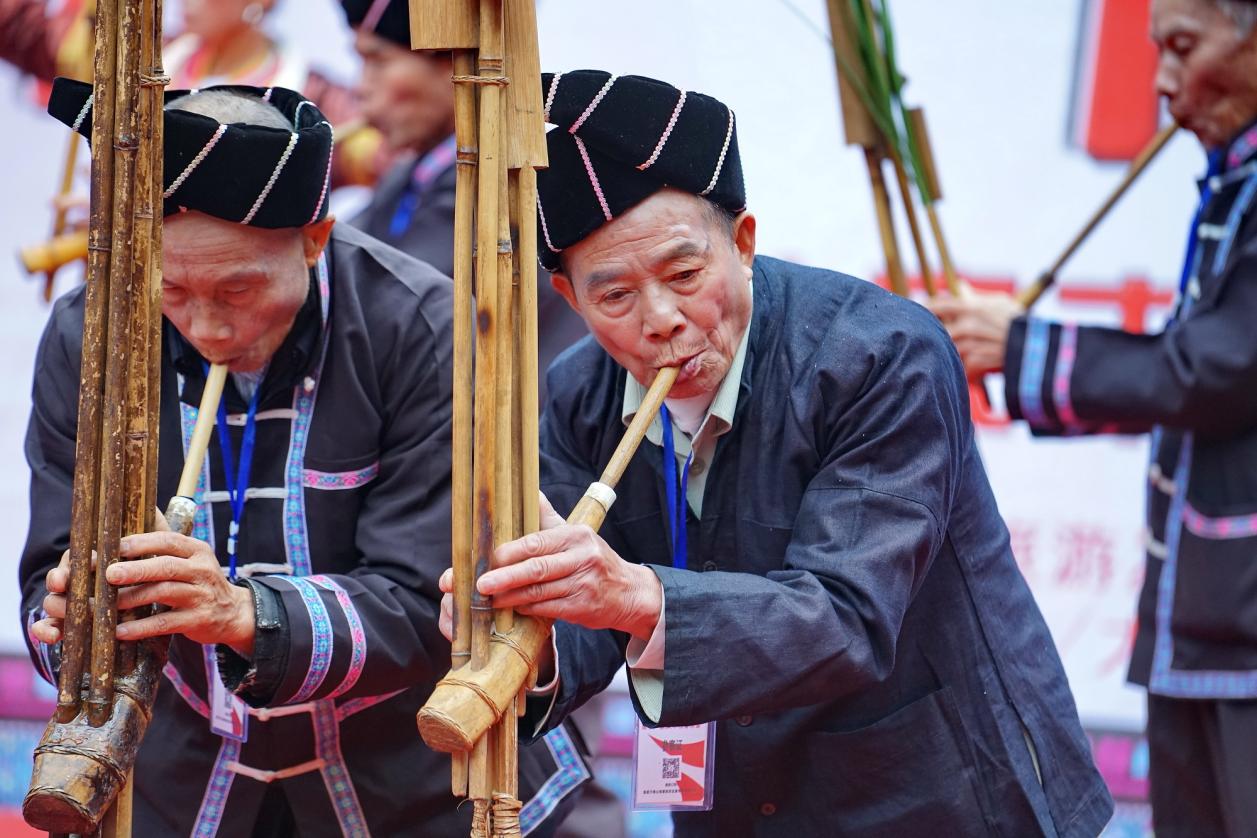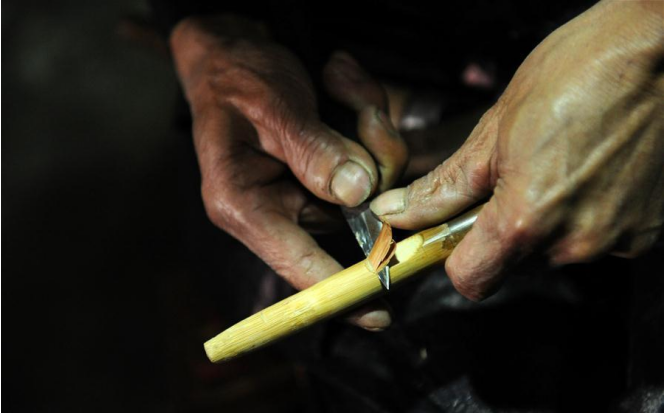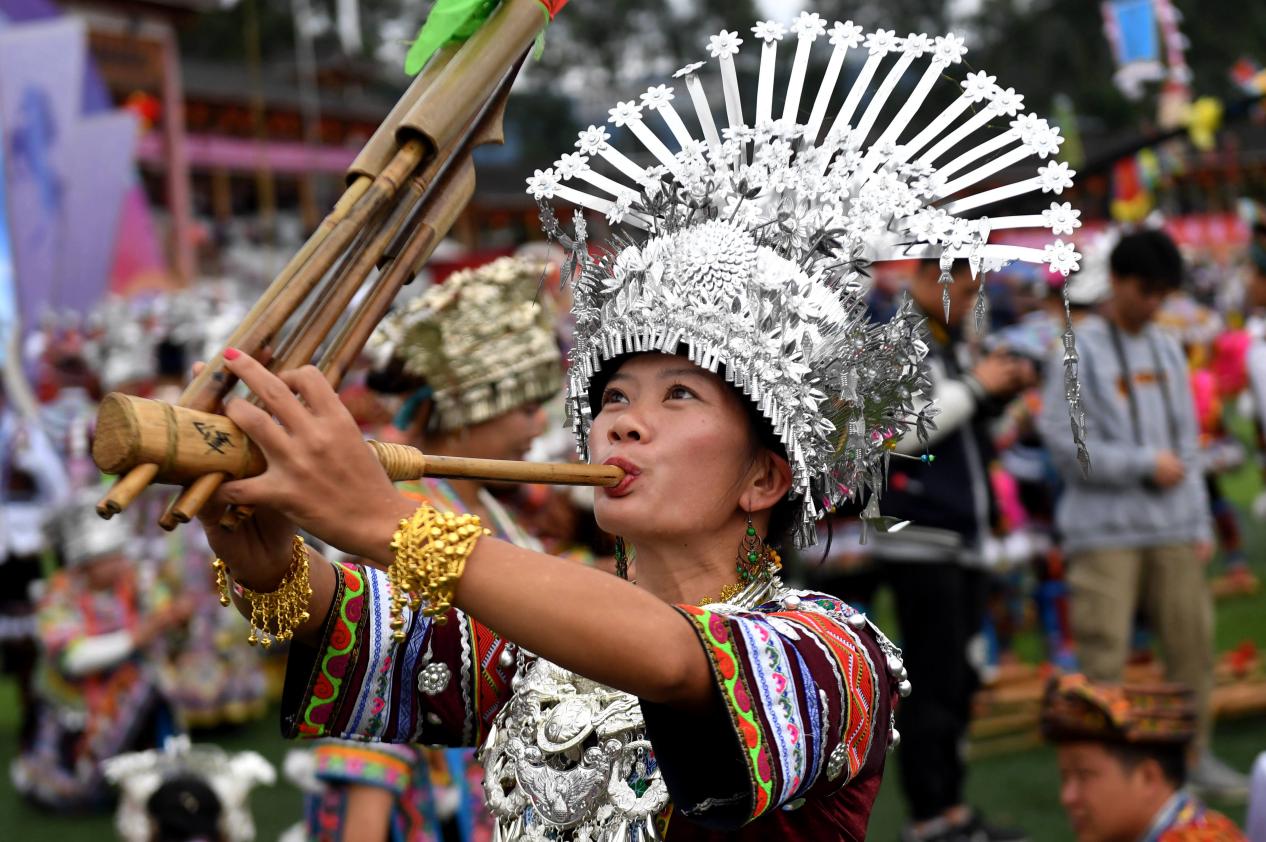

(By Mo Tingting)It is universally acknowledged that people from different cultures have their unique perspectives to think and behave. The March 3rd Festival (Sanyuesan Festival) that falls on March 3rd by the Chinese lunar calendar is the most influential festival in Guangxi. Approaching that day, some ethnic groups in Guangxi will celebrate this festival featuring a lot of activities. The soul instrument of the Miao — Lusheng, which plays an important role in passing on the Miao's culture. Now let’s escape from the madding crowd to start a tour in Rongshui Miao Autonomous County, Liuzhou, and find a lot if you have an eye for details.
A pivotal part of the Miao
The Chinese people have a strong musical culture, with documentary evidence and artifacts dated as early as the Zhou Dynasty (1046 BC-256 BC). Lusheng, a cultural form integrating songs and dances, has been developing for a long time and going quite popular among ethnic groups in southwest China such as today’s Guangxi Zhuang Autonomous Region.

Since ancient times, there has been a saying that the Miao people could not be separated from the Lusheng. By talking with three local people in the village, you can tell the Lusheng culture is in the blood of the Miao people. In legend, Lusheng is the mother of Miao nationality; in war, Lusheng is the trumpet of Miao nationality’s battle; and in Miao nationality, Lusheng is the tool of expressing emotions in festivals, harvest celebrations, weddings, funerals, love whispers and greetings. From ancient songs and legends to daily life, Lusheng is both a vital cultural emblem and a means of communicating with the spiritual world of the Miao nationality.
There is no written language in the Miao community, so the Lusheng is known as a “talking instrument” whose musical tones are meant to mimic the human voice. In 2006, Miao’s Lusheng production technology was listed in the first batch of the National Intangible Cultural Heritage List.
In some Miao people’s houses, a handful of exquisite reeds are placed in each fixed position. These reeds are the result of their work day and night. The Lusheng is typically made of bamboo and is classified as a wind instrument. What are the pipes made of? How can the Lusheng produce so many different tones? There are time-consuming procedures involved in making a Lusheng, such as choosing materials, installing reeds and whittling sound holes.

Making Lusheng not only requires a certain amount of musical knowledge, but also requires the craftsman to master some physical and mechanical knowledge. Sometimes, it takes nearly 20 days to produce a Miao Lusheng. Traditionally, craftsmen in this area used bellows, hammers, brass, axe, chisels, saws, drill bits, bitter bamboo, Chinese wood oil and calcareous to make Lusheng. The most tiring thing is to polish bamboo and the most essential technique is to make reeds. Most Lusheng consist of multiple reeds, while some have only 1 or 2 reeds. The most common number of reeds for a Lusheng among experienced Lusheng musicians is 6, which provides an adequate range of tones, from deep bass to a clear and melodious treble, while maintaining forcefulness.
Tips:Miao Lusheng’s production process is complex, generally including the selection of materials, baking materials, making reeds, bamboo and wood components, trying timbre and other dozens of processes.
A beckoning cultural feast
Sanyuesan Festival, collectively observed by many nationalities in Guangxi, has gained domestic and even international recognition. For local people, Sanyuesan Festival is a great occasion for family reunion, ancestor worship and best wishes for the upcoming year. In Rongshui Miao Autonomous County, Liuzhou, Miao people celebrate the special day as the “Festival of Love”, along with grand festive activities such as Caitang dance with Lusheng.
Being a popular music instrument among those Miao ethnic people, today Lusheng plays a key role in celebrating the Sanyuesan Festival. Lusheng fair is a sensory feast of color and sound.
Undoubtedly, for the Miao people, Caitang dance is popular on Sanyuesan and every Miao youth learns Caitang dance since their childhood. On that day, Lusheng teams from surrounding villages led by the senior of prestige go to Rongshui. As you enter Rongshui’s Miao village, you will be warmly welcomed with the road-block drinking, a local way to welcome friends from afar. From the foot of the hill to the gate of the village, there are usually twelve barriers with dressed Miao youths standing by to offer a toast to you.

Around those handsome men, a team of local Miao girls is in charming costumes. The costumes of Miao are well-known for their brilliant colors, complicated adornments and profound cultural connotations. The patterns on the costumes, which carry a historical mission to pass on the Miao culture, function as the written characters. Caitang dance often takes place in an empty space with a group of three people walking in the front and three to nine people as guiders. Miao girls usually circle in rings as they dance to the rhythm of the music performed by the boys. Young men play Lusheng when they sing songs and rhythmically step on the ground.
The ceremony is performed to bring hope for a favorable harvest in the coming year alongside good health. Lusheng is not only a means of entertainment for Miao people, but also a link between men and women to convey their love. When the festival reaches its climax, the youngsters can express their love to girls by playing Lusheng. Likewise, if a young woman has a desire for a young man, she will hang her affection on his reed.
Whether you are a man or woman, you will be deeply impressed by the ancient Chinese music and the pure love between Miao youth. Dances of Miao display and carry forward their glamorous history and culture. Despite many hardships, they have still maintained their optimism, open-mindedness and courage, which are fully demonstrated in their dances. As a visitor, you may, together with the villagers, take part in a traditional ritual and attend a banquet prepared for the festival.
Tips:Silver ornaments of Miao: Miao girls’ love for silver ornaments comes from their instincts. The headwear of Miao includes silver horn, silver fan, silver hat, silver handkerchief, silver hairpin, silver pin, etc. Once you catch sight of these silver ornaments, you may feel hard to move your eyes away.
Source: China-ASEAN Panorama
桂ICP备14000177号 Copyright@2006-2013 Guangxi China-ASEAN Panorama Magazine Agency Co., Ltd. All Rights Reserved